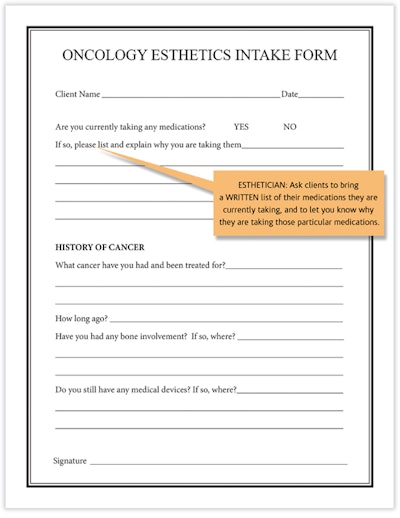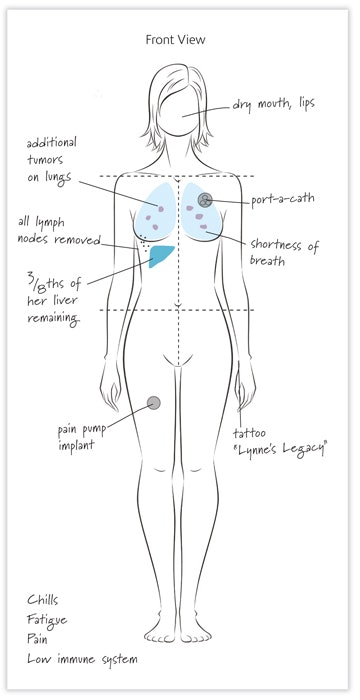
When providing a spa service to a client undergoing active cancer treatment, intake forms need to include a thorough medical history. It is also necessary to take a thorough medical history for a person with a history of cancer, since these survivors can experience long-term side effects. To understand what side effects could present either short term and/or long term, an esthetician needs to gain an understanding of the terminology used in the world of cancer, plus know what possible side effects might be visible. With this understanding, an esthetician can make informed, safe choices for modifications to any spa service that is requested.
In the best interest of the spa, the front desk staff or a designated staff member needs to have some education on cancer and its side effects if she is responsible for accurate content on intake forms. More comprehensive information results in a better outcome.
Approaching an Oncology Intake
When inquiring about a client’s medical history, set the tone to build a relationship with the client. It helps to establish clear communication. Gathering pertinent information will help the skin care professional develop a safe and effective spa service, and it can also guide the esthetician to recommend home care for the skin.
Once a client has completed the regular intake form (name, address, doctor’s info, contact info, etc.) and the client ticks off a box that indicates that she has had/has cancer, an oncology esthetics intake form needs to be completed. (See Oncology Esthetics Intake Form.)
 The oncology esthetics intake form is signed by clients the first time they visit the clinic, and it is ideal to update it every year. This informed consent ensures the client understands and consents to the treatment(s) that will be performed. In addition, the informed consent communicates any modifications during active cancer treatment and during recovery.
The oncology esthetics intake form is signed by clients the first time they visit the clinic, and it is ideal to update it every year. This informed consent ensures the client understands and consents to the treatment(s) that will be performed. In addition, the informed consent communicates any modifications during active cancer treatment and during recovery.Consultation and Modification
After reviewing the intake form contents and performing a skin analysis, the esthetician can discuss the client’s concerns with her. If the client is a first-time client, or she has recently been diagnosed with cancer, it would help tremendously if the esthetician can find a compelling and truthful rea son to find a compliment about the client’s skin, eyes or hands. This approach can help the client to relax.
The esthetician can then recommend (and possibly educate the client) modifications to the services based on all the knowledge she has gathered through this consultation. The intake form will contain a list of side effects from the different cancer treatment, and it is helpful if the client can present a list of current medications taken. Knowing what side effects are presented from each treatment can be addressed in a final recommendation—drawn or written. (See Skin Analysis Illustration.) The final recommendation can also be shown to the client. This also increases the level of trust between client and esthetician, especially if the esthetician shows an interest and empathy for each person. It is also vitally important for treatment safety and to avoid complications.
 When you complete your analysis, document your findings on the internal record as well as the home care guide for your client. Proper skin analysis is the key to developing an appropriate treatment plan and creating the client’s expectation for future treatment sessions.
When you complete your analysis, document your findings on the internal record as well as the home care guide for your client. Proper skin analysis is the key to developing an appropriate treatment plan and creating the client’s expectation for future treatment sessions.Update Frequency
The intake form on file is something that the esthetician can go back to each time the client comes for a spa service and they are able to look at the medical history. All changes need to be addressed thoroughly each time. The esthetician must make the time to complete these intake forms at the time of service, as important information can be missed with a busy schedule and lots of clients. It is easy to forget important details if not recorded.
The sign-in sheet (see Sign-in Sheet) is signed by the client every time she has a service with you. This sheet has minimal questions, but the questions cover an update to supplement, medication and side effects.
 Important Questions on Intake
Important Questions on IntakeIn addition to a medical history, questions included on the client intake form should cover all the things the esthetician needs to know to carry out safe and effective treatments. Certain procedures can have precautions and contraindications.
How are you feeling today? An important question to finish off the consultation with is, “How are you feeling today?” Many people with a cancer diagnosis are treated for anxiety and/or depression, and there are many emotions they will experience at different stages of their treatment. The easiest way to gauge a client’s feelings is to simply ask.
What is the purpose of your visit? Another important question to ask is the purpose of their service? Is this for symptom relief, relaxation and/or a body image issue?
Are you currently taking any medications? Medications, such as antibiotics, can make the skin hypersensitive. Some medications can also cause photosensitivity.
What is your sun exposure? A lot of clinical treatments require clients to wear sunscreen and limit sun exposure. Sun is necessary in small amounts, but is also a cause of skin cancers, so a client’s sun exposure patterns must be listed. Do they have intense, intermittent exposure (higher BCC risk) or accumulative exposure (higher SCC risk).
What medical conditions are you experiencing? Some medical conditions can affect wound healing. Wound management and the healing process will vary depending on their current medical conditions. For instance, a client undergoing active cancer treatment who is also a diabetic will have a longer wound healing process, and this has to be kept in mind when deciding upon services.
Are you experiencing any allergies? Is the client experiencing any allergies? People can be allergic to certain ingredients in products. Know the ingredients in your treatment products, and be aware of which ingredients can trigger an allergic reaction. Also, know which ingredients might be too harsh for sensitive skin and/or skin on a health-challenged individual. Knowing your brand of products really well is important not only for your professional recommendations, but also for home care.
What products are you using? An educated consult with the client also requires that the esthetician know what the client is currently putting on her skin. It will help the esthetician educate the client about what products she is using and whether or not it is a good fit for her skin condition. This will also help the esthetcian guide her on home care. Optimal results are only achieved through services that coincide with an effective home care regimen.
What do you like about your products? It also helps your recommendation to understand what they like or do not like about their current products to enable you to recommend a more suitable one based on their preferences and needs.
Home Care
When it comes to products for home care, product sales need to be put on the back burner to some degree. The client who is not feeling well will not appreciate being plugged a whole collection of products and have expectations to use all these products. This would be grossly unfair of the esthetician (or their employer) to push products on this client during active treatment, or if a person is feeling poorly.
Manage Risk
A thorough skin analysis and consultation can set the tone for the client relationship. If the client refuses up front, you should consider not treating her. I have seen first-hand a person refuse to answer any questions with the reply, “I can go to any spa and have a service done without answering any questions.” Spas who do not engage in completing thorough intake forms leave themselves open to lawsuits/liabilities, as it may be seen as negligent under tort law.
Does your spa have a set of self-imposed guidelines that help it avoid lawsuits and complaints? When you do get a complaint, how quickly and appropriately do you respond? Self-imposed guidelines can give the esthetician the right to refuse a service if the client refuses to provide details for an intake form.
Establish Safety
While we have all been to the doctor’s office and grumbled when we were handed numerous sheets of forms to fill out, we also did so on the understanding that the information is a pertinent part of successful client care. Implementing client intake forms in your business will give your clients a feeling of safety and security and establish you in their minds as a professional they can trust.










